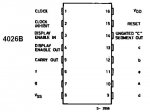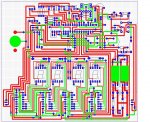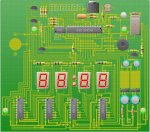Blue Eagle
Member
Hi guys, I am new here 
I am currently planning a little personal project, to build a digital alarm clock.
I am basing it around the 28X1, using a DS1307 RTC. However I need to find an effective and simple way to control the 4 7-segment displays.
The main requirement of the solution is that it can be left to it’s own devices while the picaxe does something else for example, so the program is not constantly having to keep the displays displaying
The method I have come up with is the 4015B dual 4 bit static shift register, two of these control 4x 4511 BCD decoders.
I have two main questions:
1) would this method work, and is it the easiest?
2) how does the picaxe interface with the shift register?
Regarding question 1: I don’t see anywhere that says the 4014 8 bit shift registers are ‘static’ does this mean you have to continuously send data and clock the registers? Or can you stop and start. Because I realise that 4x 8 bit registers might be more convenient than 2x 4 bit registers and 4x BCD decoders.
Regarding question 2: Is it a simple matter of taking the data pin high or low and then taking the clock pin high, and then low again. Or is there more to it such as commands that can make it simplier, or timing issues?
My plan was really to create a bunch of procedures for each number, so if after reading from the clock, I require a 4 in far right display, I run the procedure “far right 4”
Thanks in advance guys, just ask if you need me to clarify any aspects of the setup I am planning
I am currently planning a little personal project, to build a digital alarm clock.
I am basing it around the 28X1, using a DS1307 RTC. However I need to find an effective and simple way to control the 4 7-segment displays.
The main requirement of the solution is that it can be left to it’s own devices while the picaxe does something else for example, so the program is not constantly having to keep the displays displaying
The method I have come up with is the 4015B dual 4 bit static shift register, two of these control 4x 4511 BCD decoders.
I have two main questions:
1) would this method work, and is it the easiest?
2) how does the picaxe interface with the shift register?
Regarding question 1: I don’t see anywhere that says the 4014 8 bit shift registers are ‘static’ does this mean you have to continuously send data and clock the registers? Or can you stop and start. Because I realise that 4x 8 bit registers might be more convenient than 2x 4 bit registers and 4x BCD decoders.
Regarding question 2: Is it a simple matter of taking the data pin high or low and then taking the clock pin high, and then low again. Or is there more to it such as commands that can make it simplier, or timing issues?
My plan was really to create a bunch of procedures for each number, so if after reading from the clock, I require a 4 in far right display, I run the procedure “far right 4”
Thanks in advance guys, just ask if you need me to clarify any aspects of the setup I am planning




